Co-evolution of Smart Small Vehicles and Human Spatial Experiences: Case Study on Battery-Sharing Electric Two-Wheelers Experiment
Abstract
:1. Introduction
2. Theorical Background
2.1. Spatial Knowledge Acquisition
2.1.1. Affordance and Cognitive Mapping
2.1.2. Spatial Learning
2.2. Spatial Experience and Urban Travels
2.3. Techniques for Investigating Cognitive Maps
Relevant Methods to Analyze Sketch Maps
3. Materials and Methods
3.1. Research Questions
- (1)
- To what extent does spatial experience enhance spatial knowledge?
- (2)
- To what extent does an improved spatial knowledge of distance and direction correlate with increased travel satisfaction?
- (3)
- To what extent does an improved spatial knowledge of distance and direction correlate with efficient battery-swapping behaviors and complex travel patterns?
3.2. Analytical Framework
3.3. Data Collection
3.3.1. Study Site and Context
3.3.2. Participants
3.4. Sketch Map Survey
3.4.1. Survey Design
- (1)
- The road from your home to the station you use most (either a railway or monorail station).
- (2)
- The road to the university campus, assuming you are heading from your home by a motorcycle or a car.
- (i)
- Please draw without looking at a map such as Google Maps.
- (ii)
- Please mark (you may draw or write) the intersections and landmarks (e.g., buildings and facilities) on the route as much as possible.
- (iii)
- It is recommended that you first fill in the origin (i.e., your home) and destinations (i.e., the campus and station) so that they can fit within the paper sheet.
- (iv)
- The response time is about 25 min.
3.4.2. Evaluation of Sketch Maps
3.5. Questionnaire Surveys
3.6. Vehicle Tracking Data
Analysis of Trip-Chaining Behaviors
4. Results
4.1. Changes in Sketch Maps
Spatial Knowledge and On-Road Experience
4.2. Relationships between User Attitudes and Spatial Knowledge
4.2.1. Descriptive Statistics
4.2.2. Correlations between Presurvey Items and Spatial Knowledge
4.2.3. Correlations between Postsurvey Items and Spatial Knowledge
4.2.4. Two-Way ANOVA Results
4.3. Relationships between Spatial Knowledge and Urban Travel Behaviors
Trip-Chaining Behaviors
4.4. Results of Structural Relationship Analysis
5. Discussion and Conclusions
Conclusions
Author Contributions
Funding
Institutional Review Board Statement
Informed Consent Statement
Data Availability Statement
Conflicts of Interest
References
- Golledge, R.G.; Gärling, T. Cognitive maps and urban travel. In Handbook of Transport Geography and Spatial Systems; Emerald Group Publishing Limited: Bradford, UK, 2004; Volume 5, pp. 501–512. [Google Scholar]
- Mondschein, A.; Blumenberg, E.; Taylor, B.D. Cognitive mapping, travel behavior, and access to opportunity. Transp. Res. Rec. 2006, 1985, 266–272. [Google Scholar] [CrossRef]
- Mondschein, A.; Blumenberg, E.; Taylor, B. Accessibility and cognition: The effect of transport mode on spatial knowledge. Urban Stud. 2010, 47, 845–866. [Google Scholar] [CrossRef]
- Arentze, T.A.; Timmermans, H.J.P. Representing mental maps and cognitive learning in micro-simulation models of activity-travel choice dynamics. Transportation 2005, 32, 321–340. [Google Scholar] [CrossRef]
- Arentze, T.A.; Timmermans, H.J.P. Information gain, novelty seeking and travel: A model of dynamic activity-travel behavior under conditions of uncertainty. Transp. Res. Part A Policy Pract. 2005, 39, 125–145. [Google Scholar] [CrossRef]
- Manley, E.; Cheng, T. Exploring the role of spatial cognition in predicting urban traffic flow through agent-based modelling. Transp. Res. Part A Policy Pract. 2018, 109, 14–23. [Google Scholar] [CrossRef]
- Afrooz, A.; White, D.; Parolin, B. Effects of active and passive exploration of the built environment on memory during wayfinding. Appl. Geogr. 2018, 101, 68–74. [Google Scholar] [CrossRef]
- Schwinger, F.; Tanriverdi, B.; Jarke, M. Comparing Micromobility with Public Transportation Trips in a Data-Driven Spatio-Temporal Analysis. Sustainability 2022, 14, 8247. [Google Scholar] [CrossRef]
- Aman, J.J.; Zakhem, M.; Smith-Colin, J. Towards Equity in Micromobility: Spatial Analysis of Access to Bikes and Scooters amongst Disadvantaged Populations. Sustainability 2021, 13, 11856. [Google Scholar] [CrossRef]
- City of Lincoln. “Active Transportation and Micromobility”. City of Lincoln Nebraska. 2023. Available online: https://www.lincoln.ne.gov/City/Departments/LTU/Transportation/Traffic-Engineering/Active-Transportation (accessed on 5 April 2023).
- Schuitema, G.; Anable, J.; Skippon, S.; Kinnear, N. The role of instrumental, hedonic and symbolic attributes in the intention to adopt electric vehicles. Transp. Res. Part A Policy Pract. 2013, 48, 39–49. [Google Scholar] [CrossRef]
- Putri, B.A.I.; Atha, F.; Rizka, F.; Amalia, R.; Husna, S. Factors Affecting E-Scooter Sharing Purchase Intention: An Analysis Using Unified Theory of Acceptance and Use of Technology 2 (UTAUT2). Int. J. Creat. Bus. Manag. 2021, 1, 58–73. [Google Scholar] [CrossRef]
- Kopplin, C.S.; Brand, B.M.; Reichenberger, Y. Consumer acceptance of shared e-scooters for urban and short-distance mobility. Transp. Res. Part D Transp. Environ. 2021, 91, 102680. [Google Scholar] [CrossRef]
- Curtale, R.; Liao, F. User Acceptance and Preferences of Sharing Mobility Services. 2020. Available online: https://research.tue.nl/en/publications/user-acceptance-and-preferences-of-sharing-mobility-services (accessed on 12 September 2022).
- Finke, S.; Schelte, N.; Severengiz, S.; Fortkort, M.; Kähler, F. Can battery swapping stations make micro-mobility more environmentally sustainable? E3S Web Conf. 2022, 349, 02007. [Google Scholar] [CrossRef]
- Saur Energy. Here’s How Taiwan’s Gogoro Leads with Innovation in Electric Two-Wheeler Industry. 2022. Available online: https://www.saurenergy.com/ev-storage/heres-how-taiwans-gogoro-leads-with-innovation-in-electric-two-wheeler-industry (accessed on 23 September 2022).
- Cadwallader, M.T. Cognitive Distance in Intraurban Space. In Environmental Knowing; Moore, G.T., Golledge, R.G., Eds.; Dowden, Hutchinson & Ross: Stroudsburg, PA, USA, 1976; pp. 316–324. [Google Scholar]
- Downs, R.M.; Stea, D. (Eds.) Image and Environment: Cognitive Mapping and Spatial Behavior; Transaction Publishers: Piscataway, NJ, USA, 2017. [Google Scholar]
- Lynch, K. The Image of the City; MIT Press: Cambridge, MA, USA, 1960. [Google Scholar]
- Hart, R.A.; Moore, G.T. The Development of Spatial Cognition: A Review. In Image & Environment: Cognitive Mapping and Spatial Behavior; Downs, R.M., Stea, D., Eds.; AldineTransaction: Piscataway, NJ, USA, 1973; pp. 246–288. [Google Scholar]
- Evans, G.W. Environmental cognition. Psychol. Bull. 1980, 88, 259. [Google Scholar] [CrossRef]
- Ahmadpoor, N.; Shahab, S. Spatial knowledge acquisition in the process of navigation: A review. Curr. Urban Stud. 2019, 7, 1–19. [Google Scholar] [CrossRef]
- Palmer, S. Fundamental aspects of cognitive representation. In Cognition and Categorization; Rosch, E., Lloyd, B.B., Eds.; Erlbaum: Hilldale, NJ, USA, 1978. [Google Scholar]
- Appleyard, D. Why buildings are known: A predictive tool for architects and planners. Environ. Behav. 1969, 1, 131–156. [Google Scholar] [CrossRef]
- Appleyard, D. Styles and methods of structuring a city. Environ. Behav. 1970, 2, 100–117. [Google Scholar] [CrossRef]
- Siegel, A.W.; White, S.H. The development of spatial representations of large-scale environments. Adv. Child Dev. Behav. 1975, 10, 9–55. [Google Scholar]
- Moore, G.T. Knowing about environmental knowing: The current state of theory and research on environmental cognition. Environ. Behav. 1979, 11, 33–70. [Google Scholar] [CrossRef]
- Appleyard, D. The environment as a social symbol: Within a theory of environmental action and perception. J. Am. Plan. Assoc. 1979, 45, 143–153. [Google Scholar] [CrossRef]
- Appleyard, D. Urban trees, urban forests: What do they mean. In Proceedings of the National Urban Forestry Conference, Washington, DC, USA, 13–16 November 1979; pp. 138–155. [Google Scholar]
- Gibson, J.J. The senses considered as perceptual systems. J. Mind Behav. 1966, 79, 145. [Google Scholar]
- Gibson, J.J. The Ecological Approach to Visual Perception: Classic Edition; Psychology Press: London, UK, 1979. [Google Scholar]
- Lazarus, R.S. Cognition and motivation in emotion. Am. Psychol. 1991, 46, 352. [Google Scholar] [CrossRef] [PubMed]
- Maier, J.R.; Fadel, G.M.; Battisto, D.G. An affordance-based approach to architectural theory, design, and practice. Des. Stud. 2009, 30, 393–414. [Google Scholar] [CrossRef]
- Hartson, R. Cognitive, physical, sensory, and functional affordances in interaction design. Behav. Inf. Technol. 2003, 22, 315–338. [Google Scholar] [CrossRef]
- Marcus, L.; Giusti, M.; Barthel, S. Cognitive affordances in sustainable urbanism: Contributions of space syntax and spatial cognition. J. Urban Des. 2016, 21, 439–452. [Google Scholar] [CrossRef]
- Stern, E.; Leiser, D. Levels of spatial knowledge and urban travel modeling. Geogr. Anal. 1988, 20, 140–155. [Google Scholar] [CrossRef]
- Golledge, R.G. Learning about urban environment. In Timing Space and Spacing Time, Making Sense of Time; Edward Arnold: London, UK, 1978; Volume 1, pp. 76–98. [Google Scholar]
- Couclelis, H.; Golledge, R.G.; Gale, N.; Tobler, W. Exploring the anchor-point hypothesis of spatial cognition. J. Environ. Psychol. 1987, 7, 99–122. [Google Scholar] [CrossRef]
- Hazen, N.L. Spatial exploration and spatial knowledge: Individual and developmental differences in very young children. Child Dev. 1982, 53, 826–833. [Google Scholar] [CrossRef]
- Vilnai-Yavetz, I.; Rafaeli, A. Workspace Integration and Sustainability: Linking the Symbolic and Social Affordances of the Workspace to Employee Wellbeing. Sustainability 2021, 13, 11985. [Google Scholar] [CrossRef]
- Wineman, J.D.; Peponis, J. Constructing spatial meaning: Spatial affordances in museum design. Environ. Behav. 2010, 42, 86–109. [Google Scholar] [CrossRef]
- Samarasekara, G.N.; Fukahori, K.; Kubota, Y. Effect of street trees on spatial cognition in residential areas: An investigation based on development perspective. J. Archit. Infrastruct. Environ. 2009, 7, 75–86. Available online: http://library.jsce.or.jp/jsce/open/00911/2009/07/07-0075.pdf (accessed on 12 September 2022).
- Mirzaei, E.; Kheyroddin, R.; Behzadfar, M.; Mignot, D. Utilitarian and hedonic walking: Examining the impact of the built environment on walking behavior. Eur. Transp. Res. Rev. 2018, 10, 20. [Google Scholar] [CrossRef]
- Garling, T.; Book, A.; Lindberg, E. Cognitive mapping of large-scale environments: The interrelationship of action plans, acquisition, and orientation. Environ. Behav. 1984, 16, 3–34. [Google Scholar] [CrossRef]
- Zomer, L.B. Unravelling Urban Wayfinding: Studies on the Development of Spatial Knowledge, Activity Patterns, and Route Dynamics of Cyclists. Ph.D. Thesis, Delft University of Technology, Delft, The Netherlands, 2021. [Google Scholar]
- Schneider, F.; Ton, D.; Zomer, L.B.; Daamen, W.; Duives, D.; Hoogendoorn-Lanser, S.; Hoogendoorn, S. Trip chain complexity: A comparison among latent classes of daily mobility patterns. Transportation 2021, 48, 953–975. [Google Scholar] [CrossRef]
- Schneider, F.; Daamen, W.; Hoogendoorn, S. Trip chaining of bicycle and car commuters: An empirical analysis of detours to secondary activities. Transp. A Transp. Sci. 2022, 18, 855–878. [Google Scholar] [CrossRef]
- Foreman, N.; Gillett, R. (Eds.) A Handbook of Spatial Research Paradigms and Methodologies; Psychology Press: Hove, UK, 1997; Volume 2. [Google Scholar]
- Els, H.; Janssens, D.; Wets, G. Proximity is a state of mind: Exploring mental maps in daily activity travel behaviour. In Proceedings of the 11th International Conference on Travel Behaviour Research, Kyoto, Japan, 16–20 August 2006. [Google Scholar]
- Kruskal, J.B.; Wish, M. Multidimensional Scaling; Sage: Newcastle upon Tyne, UK, 1978; Volume 11. [Google Scholar]
- Shoben, E.J. Applications of multidimensional scaling in cognitive psychology. Appl. Psychol. Meas. 1983, 7, 473–490. [Google Scholar] [CrossRef]
- Allen, G.L.; Siegel, A.W.; Rosinski, R.R. The role of perceptual context in structuring spatial knowledge. J. Exp. Psychol. Hum. Learn. Mem. 1978, 4, 617. [Google Scholar] [CrossRef]
- Regian, J.W.; Yadrick, R.M. Assessment of configurational knowledge of naturally-and artificially-acquired large-scale space. J. Environ. Psychol. 1994, 14, 211–223. [Google Scholar] [CrossRef]
- Waller, D.; Haun, D.B. Scaling techniques for modeling directional knowledge. Behav. Res. Methods Instrum. Comput. 2003, 35, 285–293. [Google Scholar] [CrossRef]
- MacKay, D.B. The effect of spatial stimuli on the estimation of cognitive maps. Geogr. Anal. 1976, 8, 439–452. [Google Scholar] [CrossRef]
- Baird, J.C.; Merrill, A.A.; Tannenbaum, J. Studies of the cognitive representation of spatial relations: II. A familiar environment. J. Exp. Psychol. Gen. 1979, 108, 92. [Google Scholar] [CrossRef]
- Furlough, C.; Gillan, D.J. Assessing the Ability of Multidimensional Scaling and Pathfinder Networks to Measure Spatial Knowledge. In Proceedings of the Human Factors and Ergonomics Society Annual Meeting, Baltimore, MA, USA, 3–8 October 2021; Sage Publications: Los Angeles, CA, USA; Volume 64, pp. 303–307. [Google Scholar]
- De Jonge, D. Images of urban areas their structure and psychological foundations. J. Am. Inst. Plan. 1962, 28, 266–276. [Google Scholar] [CrossRef]
- Gulick, J. Images of an Arab city. J. Am. Inst. Plan. 1963, 29, 179–198. [Google Scholar] [CrossRef]
- Matthews, M.H. The mental maps of children: Images of Coventry’s city centre. Geography 1980, 65, 169–179. [Google Scholar]
- Golledge, R.G. Multidimensional analysis in the study of environmental behavior and environmental design. In Human Behavior and Environment; Springer: Boston, MA, USA, 1977; Volume 2, pp. 1–42. [Google Scholar]
- Moore, G.T.; Golledge, R.G. Environmental Knowing: Theories, Research and Methods; Dowden: Stroudsburg, PA, USA, 1976. [Google Scholar]
- Banerjee, T.; Baer, W.C. Beyond the Neighborhood Unit: Residential Environments and Public Policy; Springer Science Business Media: Berlin/Heidelberg, Germany, 2013. [Google Scholar]
- Minaei, N. Do modes of transportation and GPS affect cognitive maps of Londoners? Transp. Res. Part A Policy Pract. 2014, 70, 162–180. [Google Scholar] [CrossRef]
- Iavarone, A.H.; Hasgül, E. The City Experience with Location-Based Media: An Examination through Cognitive Maps. ICONARP Int. J. Archit. Plan. 2021, 9, 363–380. [Google Scholar] [CrossRef]
- Evans, G.W.; Marrero, D.G.; Butler, P.A. Environmental learning and cognitive mapping. Environ. Behav. 1981, 13, 83–104. [Google Scholar] [CrossRef]
- Siegel, A.W.; Schadler, M. Young children’s cognitive maps of their classroom. Child Dev. 1977, 48, 88–94. [Google Scholar]
- Moore, G.T. Developmental differences in environmental cognition. In Environmental Design Research; Preisser, W., Ed.; Dowden, Hutchinson Ross: Stroudsburg, PA, USA, 1973. [Google Scholar]
- Thorndyke, P.W.; Hayes-Roth, B. Differences in spatial knowledge acquired from maps and navigation. Cogn. Psychol. 1982, 14, 560–589. [Google Scholar] [CrossRef]
- Waller, D.; Hunt, E.; Knapp, D. Measuring spatial knowledge in a virtual environment: Distances and angles. In Proceedings of the 39th Annual Meeting of the Psychonomics Society, Dallas, TX, USA, 19–22 November 1998; Volume 21. [Google Scholar]
- Ishikawa, T.; Zhou, Y. Improving cognitive mapping by training for people with a poor sense of direction. Cogn. Res. Princ. Implic. 2020, 5, 39. [Google Scholar] [CrossRef]
- Melnykov, V.; Maitra, R. Finite mixture models and model-based clustering. Stat. Surv. 2010, 4, 80–116. [Google Scholar] [CrossRef]
- McLachlan, G.J. Model-based clustering. In Comprehensive Chemometrics: Chemical and Biochemical Data Analysis; Elsevier: Oxford, UK, 2009; pp. 655–681. [Google Scholar] [CrossRef]
- Levene, H. Robust tests for equality of variances. In Contributions to Probability and Statistics; Essays in honor of Harold Hotelling; Stanford University Press: Redwood City, CA, USA, 1961; pp. 279–292. [Google Scholar]
- Osaka Prefectural Government. The 5th Nationwide Person Trip Survey in Kansai Region. 2012. Available online: https://www.pref.osaka.lg.jp/toshikotsu/kinki-pt/index.html (accessed on 12 September 2022).
- Toyonaka City. Public Transport Improvement Plan. 2019. Available online: https://www.city.toyonaka.osaka.jp/machi/kotsuanzen/keikaku/koutuukeikaku.files/koukyoukoutuukaizennkneikaku.pdf (accessed on 12 September 2022).
- Smith, J.B.; Colgate, M. Customer value creation: A practical framework. J. Mark. Theory Pract. 2007, 15, 7–23. [Google Scholar] [CrossRef]
- Ohba, H.; Kishimoto, T. Analysis of Trip Chains’ Shapes and Regional Differences Using the People Flow Data. In Proceedings of the International Symposium on City Planning 2013, Hanoi, Vietnam, 22–24 August 2013; Available online: http://wwwnew.cpij.or.jp/com/iac/sympo/13/ISCP2013-98.pdf (accessed on 12 September 2022).
- Maskey, R.; Fei, J.; Nguyen, H.O. Use of exploratory factor analysis in maritime research. Asian J. Shipp. Logist. 2018, 34, 91–111. [Google Scholar] [CrossRef]
- Hair, J.F. Multivariate Data Analysis; Kennesaw State University: Kennesaw, GA, USA, 2009. [Google Scholar]
- Huang, H.-D.; Zhang, Q. Distance-construal relationship: Mediating role of perceived control and moderating role of locus of control. Front. Psychol. 2023, 13, 975417. [Google Scholar] [CrossRef] [PubMed]
- Davis, H.E.; Gurven, M.; Cashdan, E. Navigational Experience and the Preservation of Spatial Abilities into Old Age among a Tropical Forager-Farmer Population. Top. Cogn. Sci. 2023, 15, 187–212. [Google Scholar] [CrossRef]
- Davis, H.E.; Stack, J.; Cashdan, E. Cultural change reduces gender differences in mobility and spatial ability among seminomadic pastoralist-forager children in northern Namibia. Hum. Nat. 2021, 32, 178–206. [Google Scholar] [CrossRef]
- Kahneman, D.; Kahneman, D.; Tversky, A. Experienced utility and objective happiness: A moment-based approach. Psychol. Econ. Decis. 2003, 1, 187–208. [Google Scholar]
- Binswanger, M. Why does income growth fail to make us happier? Searching for the treadmills behind the paradox of happiness. J. Socio-Econ. 2006, 35, 366–381. [Google Scholar] [CrossRef]
- Inci, M.; Savrun, M.M.; Çelik, Ö. Integrating electric vehicles as virtual power plants: A comprehensive review on vehicle-to-grid (V2G) concepts, interface topologies, marketing and future prospects. J. Energy Storage 2022, 55, 105579. [Google Scholar] [CrossRef]
- Mou, X.; Zhao, R.; Gladwin, D.T. Vehicle to vehicle charging (V2V) bases on wireless power transfer technology. In Proceedings of the IECON 2018—44th Annual Conference of the IEEE Industrial Electronics Society (IEEE), Washington, DC, USA, 21–23 October 2018; pp. 4862–4867. [Google Scholar]
- İnci, M.; Büyük, M.; Özbek, N.S. Sliding mode control for fuel cell supported battery charger in vehicle-to-vehicle interaction. Fuel Cells 2022, 22, 212–226. [Google Scholar] [CrossRef]
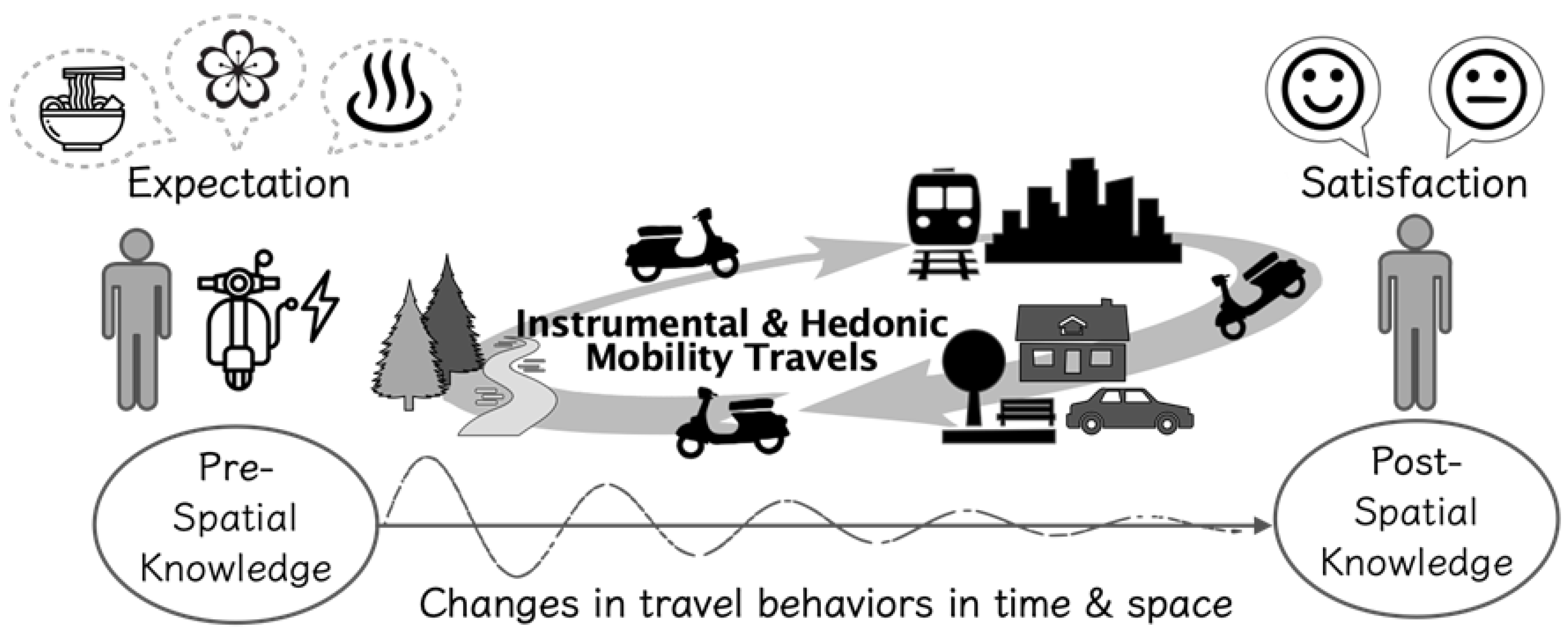


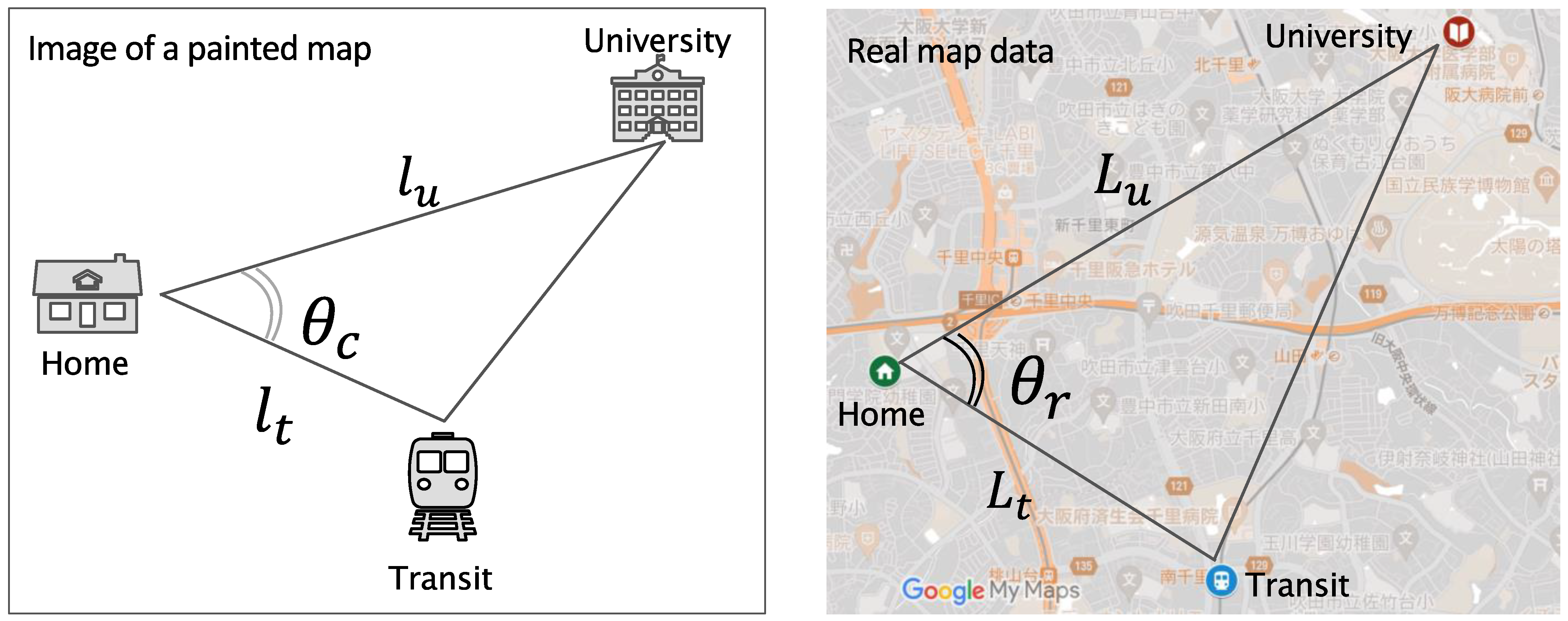


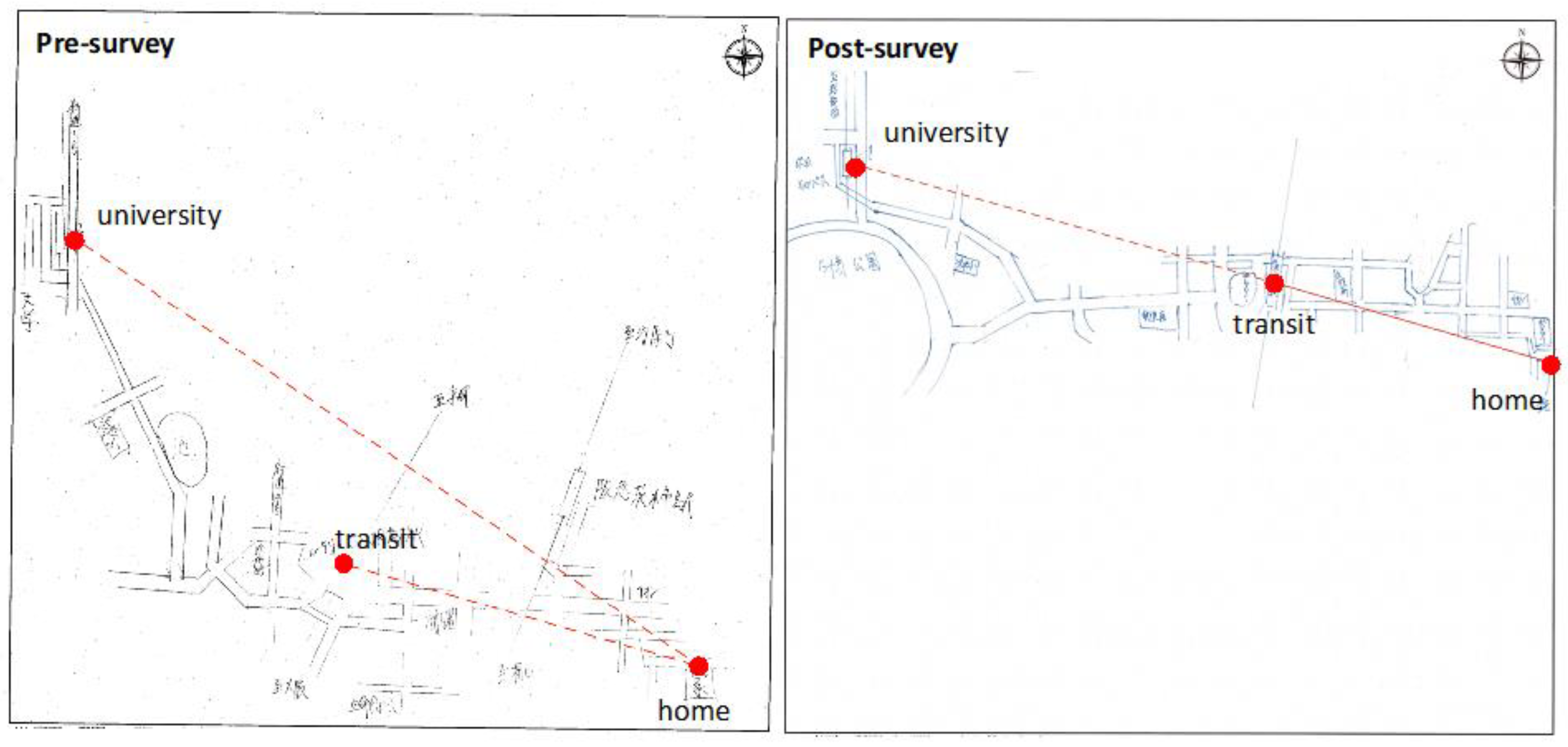
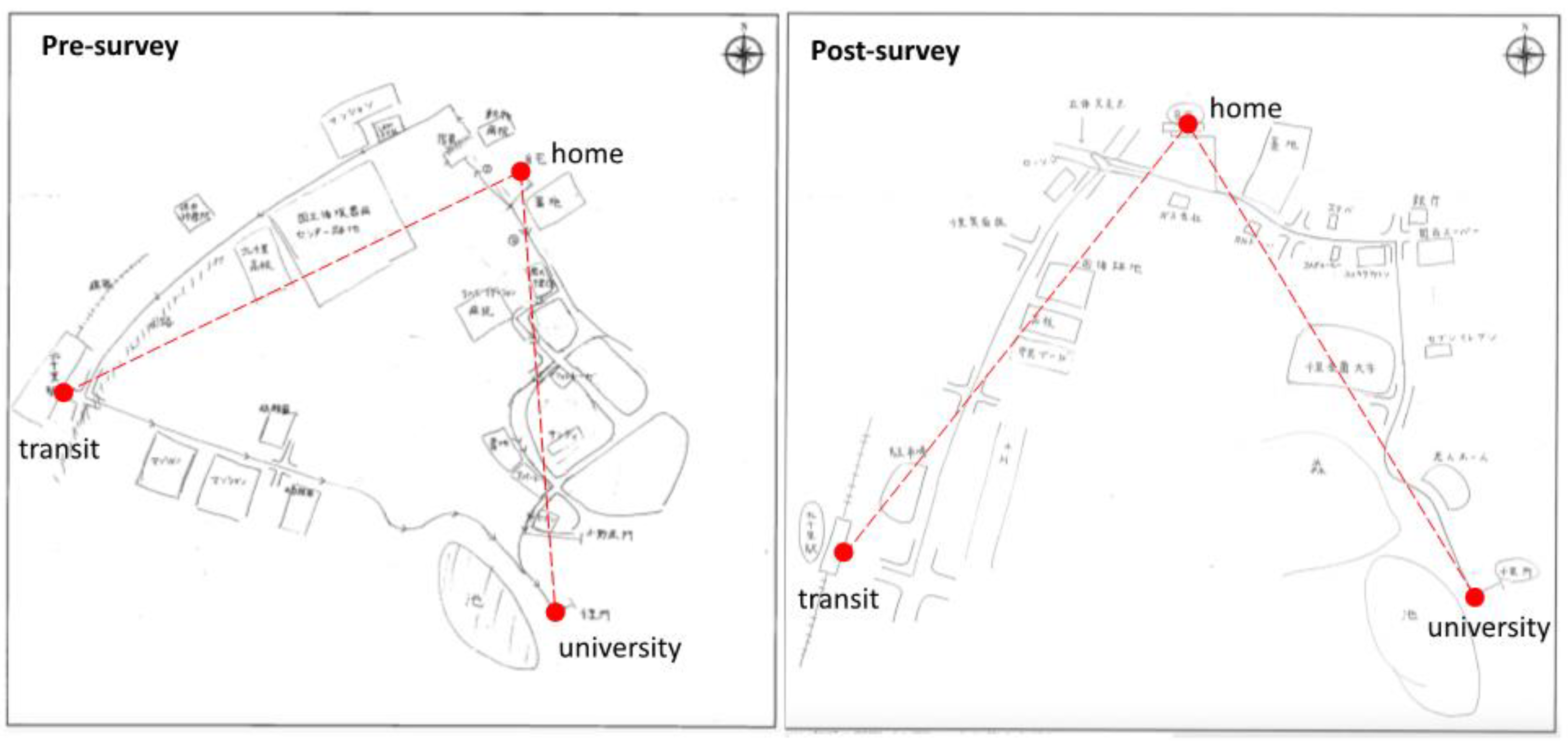
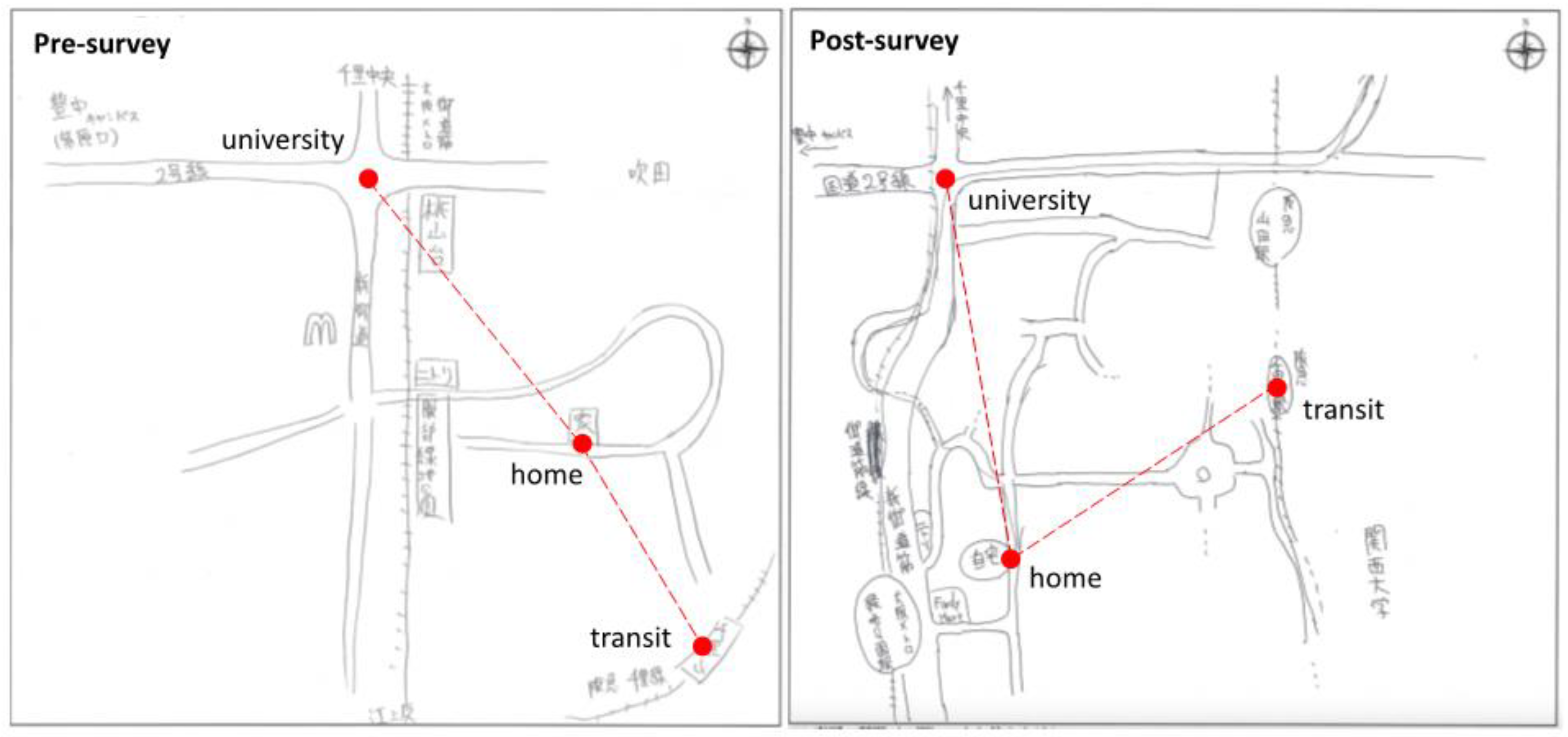
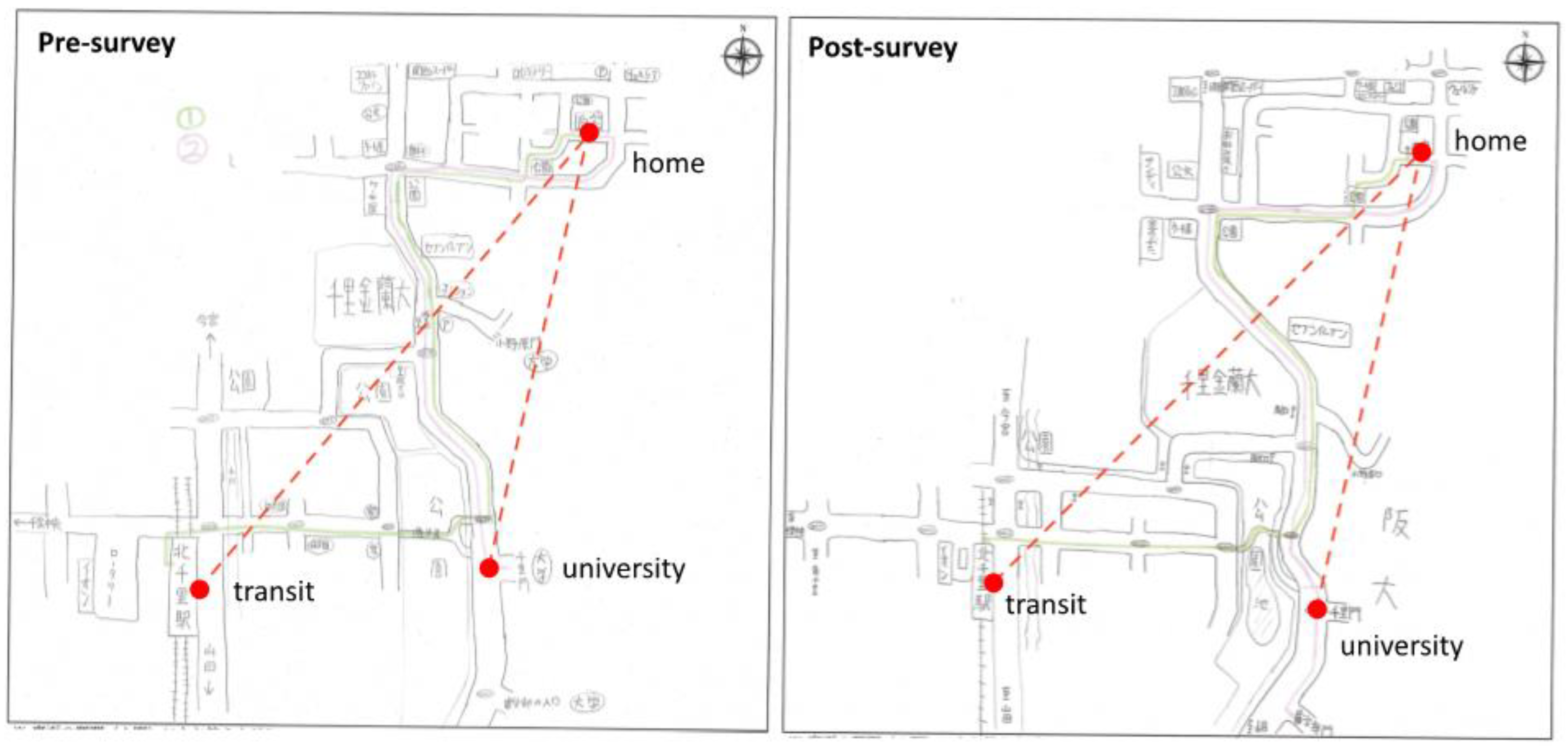


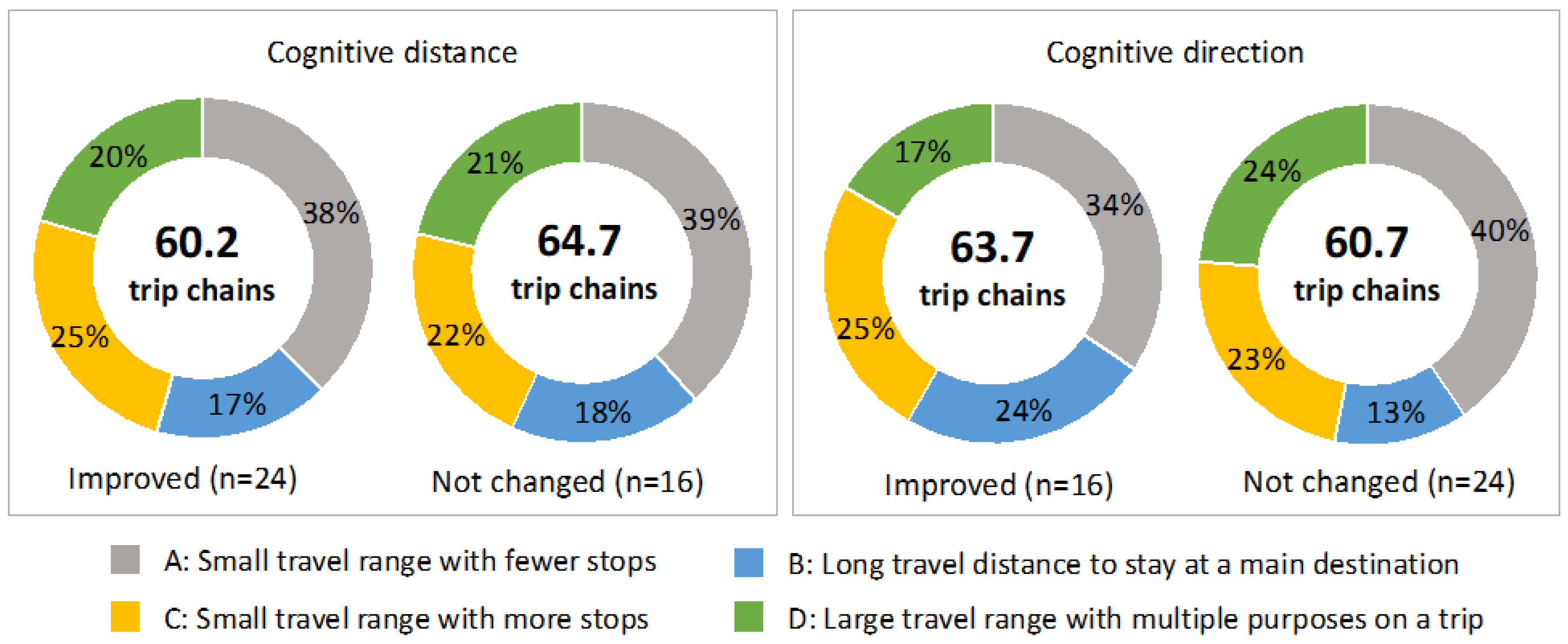

| Characteristics | Category | Sample Size | Percentage (%) |
|---|---|---|---|
| Gender | Male | 36 | 87.8 |
| Female | 5 | 12.2 | |
| Education | Undergraduate | 25 | 61.0 |
| Master’s student | 12 | 29.3 | |
| Doctoral student | 4 | 9.8 | |
| Car driving license | Yes | 38 | 92.7 |
| No | 3 | 7.3 | |
| Driving frequency | 3–5 times a week | 3 | 7.3 |
| 1–2 times a week | 5 | 12.2 | |
| 1–4 times a month | 17 | 41.5 | |
| Less than 1 time a month | 13 | 31.7 | |
| License for two-wheelers * | Moped (≤50 cc) | 9 | 22.0 |
| Small (≤125 cc) | 1 | 2.4 | |
| General (≤400 cc) | 5 | 12.2 | |
| Large (>400) | 3 | 7.3 | |
| No | 27 | 65.9 | |
| Riding frequency | 6–7 times a week | 5 | 12.2 |
| 3–5 times a week | 5 | 12.2 | |
| 1–2 times a week | 3 | 7.3 | |
| 1–4 time a month | 3 | 7.3 | |
| Less than 1 time a month | 13 | 31.7 | |
| No experience | 12 | 29.3 | |
| Main way to commute to | Rail transit | 4 | 9.8 |
| school * | Bus | 2 | 4.9 |
| Two-wheelers | 5 | 12.2 | |
| Electric bicycle | 5 | 12.2 | |
| Bicycle | 30 | 73.2 | |
| Walk | 8 | 19.5 |
| Total Distances (km) | Trip Chains | Swapping Times | Residual Power (%) | |
|---|---|---|---|---|
| Mean | 800.20 | 62.0 | 22.9 | 47.23 |
| Min | 63.4 | 7 | 3 | 22.7 |
| Max | 5512.0 | 361 | 70 | 77.3 |
| S.D. | 1065.16 | 72.03 | 15.30 | 11.39 |
| Home–Uni. (m) | Home–Trans. (m) | |||||
|---|---|---|---|---|---|---|
| Descriptive statistics (N = 41) | ||||||
| Mean | 0.648 | 0.725 | 0.894 | 0.886 | 2264.1 | 925.2 |
| Min | 0.130 | 0.166 | 0.372 | 0.589 | 50 | 113 |
| Max | 1.000 | 0.998 | 1.000 | 1.000 | 10,100 | 2740 |
| S.D. | 0.260 | 0.260 | 0.114 | 0.087 | 2012.42 | 708.89 |
| Correlation matrix | ||||||
| pre- | 1.000 | |||||
| post- | 0.525 ** | 1.000 | ||||
| pre- | 0.153 | −0.007 | 1.000 | |||
| post- | 0.121 | 0.078 | 0.324 * | 1.000 | ||
| home–uni. | −0.563 ** | −0.322 * | −0.198 | −0.141 | 1.000 | |
| home–trans. | 0.364 * | 0.418 ** | −0.188 | −0.013 | 0.049 | 1.000 |
| Items (N = 41) | Mean | S.D. | |
|---|---|---|---|
| Functional/instrumental motivations (1 = no expect to 4 = strongly expect) | |||
| IM1 | Through riding an E2W, I can move freely and smoothly on the roads | 3.39 | 0.628 |
| IM2 | I am able to travel over a larger area than before using an E2W | 3.07 | 1.058 |
| IM3 | Through riding an E2W, I am able to move faster | 2.98 | 1.151 |
| IM4 | Because the batteries are swappable, there is no need to wait for recharge | 3.15 | 0.910 |
| Experiential/hedonic motivations (1 = disagree to 4 = strongly agree) | |||
| HM1 | I join in this project because I am interested in powered two-wheelers | 3.41 | 0.774 |
| HM2 | I join in this project because I am interested in electric two-wheelers | 3.17 | 0.803 |
| HM3 | I join in this project because I am interested in the battery-swapping mechanism | 3.00 | 0.866 |
| HM4 | I join in this project because I like riding two-wheelers | 3.27 | 0.923 |
| Items (N = 40) | Mean | S.D. | |
|---|---|---|---|
| Functional/instrumental satisfaction (1 = dissatisfied to 5 = satisfied) | |||
| IS1 | Through riding an E2W, I have been able to move freely and smoothly on the roads | 4.68 | 0.694 |
| IS2 | I have been able to travel over a larger area than before using an E2W | 4.40 | 0.928 |
| IS3 | Through riding an E2W, I have been able to move faster | 4.43 | 1.035 |
| IS4 | Because the batteries are swappable, there is no need to wait for recharge | 4.58 | 0.813 |
| Experiential/Hedonic satisfaction (1 = decreased to 5 = increased) | |||
| HS1 | Interests in powered two-wheelers | 4.50 | 0.784 |
| HS2 | Interests in electric two-wheelers | 4.33 | 0.859 |
| HS3 | Interests in battery swapping mechanism | 4.35 | 0.700 |
| HS4 | Interests in riding two-wheelers | 4.47 | 0.877 |
| Satisfactions regarding the battery-swappable mobility (1 = dissatisfied to 5 = satisfied) | |||
| BS1 | Driving range of a fully charged E2W | 2.25 | 1.104 |
| BS2 | Driving range when considering battery-swapping services | 2.95 | 1.085 |
| BS3 | Time spent on swapping the batteries | 4.55 | 0.815 |
| BS4 | Battery-swappable E2W fits to my lifestyle | 4.05 | 1.085 |
| Lifestyle changes (1 = disagree to 4 = strongly agree) | |||
| LS1 | Expanded range of daily activities | 2.83 | 1.010 |
| LS2 | Increased visits to nearby café and commercial facilities | 2.42 | 1.059 |
| LS3 | Increased interests in electric mobility in addition to E2W | 3.00 | 1.013 |
| Concerns (1 = not concerned to 4 = strongly concerned) | |||
| CN1 | Increased likelihood of being involved in a traffic accident | 2.50 | 0.987 |
| CN2 | Battery charge runs out while driving | 2.93 | 1.095 |
| Items | Presurvey | Postsurvey | |||
|---|---|---|---|---|---|
| IM1 | Move freely and smoothly | 0.073 | 0.052 | −0.029 | 0.262 |
| IM2 | Travel a larger area | 0.316 * | 0.091 | 0.168 | 0.249 |
| IM3 | Move faster | 0.217 | 0.106 | 0.181 | 0.207 |
| IM4 | No need to wait for recharge | −0.033 | 0.224 | 0.039 | 0.071 |
| HM1 | Interest in powered two-wheelers | 0.173 | 0.030 | 0.111 | 0.262 |
| HM2 | Interest in electric two-wheelers | 0.061 | 0.283 | −0.185 | 0.373 * |
| HM3 | Interest in battery swapping | −0.172 | 0.238 | −0.272 | 0.012 |
| HM4 | Like riding two-wheelers | 0.144 | 0.029 | −0.083 | 0.281 |
| Items | Postsurvey | Changes in Spatial Knowledge | |||
|---|---|---|---|---|---|
| _change | _change | ||||
| IS1 | Move freely and smoothly | −0.210 | −0.064 | −0.193 | −0.095 |
| IS2 | Travel a larger area | 0.162 | 0.122 | 0.004 | 0.134 |
| IS3 | Move faster | 0.052 | 0.122 | −0.127 | 0.108 |
| IS4 | No need to wait for recharge | −0.079 | −0.034 | −0.217 | −0.258 |
| HS1 | Interest in powered two-wheelers | −0.002 | 0.181 | −0.035 | 0.115 |
| HS2 | Interest in electric two-wheelers | −0.033 | 0.456 ** | 0.079 | 0.271 |
| HS3 | Interest in battery swapping | −0.031 | 0.341 * | 0.057 | 0.188 |
| HS4 | Like riding two-wheelers | −0.063 | 0.167 | −0.212 | 0.260 |
| BS1 | Driving range of a fully charged EV | −0.105 | 0.099 | −0.258 | −0.044 |
| BS2 | Driving range with battery swapping | −0.045 | 0.302 | −0.196 | 0.171 |
| BS3 | Time spent on battery swapping | 0.344 * | −0.259 | 0.109 | −0.430 ** |
| BS4 | E2W fits lifestyle | 0.230 | 0.266 | 0.054 | 0.036 |
| LS1 | Expanded daily activity range | 0.000 | 0.218 | 0.000 | 0.452 ** |
| LS2 | Increased leisure trips (e.g., café, shops) | 0.011 | 0.251 | 0.026 | 0.359 * |
| LS3 | Increased interests in other mobility options | −0.084 | 0.423 ** | 0.094 | 0.225 |
| CN1 | Concerns about traffic accidents | 0.008 | 0.258 | 0.106 | 0.205 |
| CN2 | Concerns about battery depletion | −0.414 ** | 0.009 | −0.173 | 0.083 |
| Indicators | Postsurvey | Changes in Spatial Knowledge | ||
|---|---|---|---|---|
| _change | _change | |||
| Trip chains | −0.032 | 0.301 | −0.025 | 0.157 |
| Total distances | −0.187 | 0.202 | −0.009 | 0.088 |
| Battery-swapping times | −0.091 | 0.114 | 0.121 | −0.017 |
| Residual power | −0.063 | −0.356 * | −0.274 | −0.340 * |
| PC 1 | PC 2 | PC 3 | |
|---|---|---|---|
| Eigenvalues | 4.8872 | 1.7609 | 1.3544 |
| Proportion of variance | 0.4443 | 0.1601 | 0.1231 |
| Cumulative proportion | 0.4443 | 0.6044 | 0.7275 |
| variables | |||
| Number of destinations | −0.756 | 0.237 | 0.157 |
| Distance to the main destination | −0.434 | −0.809 | 0.093 |
| Width on the basis of main destination | −0.825 | 0.205 | −0.179 |
| Ratio of width to distance of main destination | −0.164 | 0.250 | 0.360 |
| Distance to the farthest destination | −0.737 | −0.613 | 0.140 |
| Width on the basis of farthest destination | −0.876 | 0.205 | −0.337 |
| Ratio of width to distance of farthest destination | −0.574 | 0.507 | −0.373 |
| Convex hull (m2) | −0.862 | −0.013 | −0.245 |
| Total travel distance | −0.875 | −0.303 | 0.143 |
| Staying duration at the main destination | −0.220 | 0.248 | 0.696 |
| Staying duration at the subdestination | −0.472 | 0.345 | 0.568 |
| Cluster | A | B | C | D |
|---|---|---|---|---|
| Number of chains (Proportion) | 955 (39.4%) | 369 (15.2%) | 549 (22.7%) | 549 (22.7%) |
| PC 1 | 1.560 | 0.080 | 0.200 | −2.968 |
| PC 2 | 0.159 | −1.358 | 0.967 | −0.332 |
| PC 3 | −0.062 | 0.354 | −0.421 | 0.292 |
| Mean value | ||||
| Number of destinations | 1.3 | 2.0 | 2.7 | 4.4 |
| Distance to the main destination (km) | 1.71 | 5.59 | 1.74 | 5.40 |
| Distance to the farthest destination (km) | 1.65 | 5.59 | 2.13 | 7.22 |
| Total travel distance (km) | 5.60 | 16.73 | 9.06 | 26.91 |
| Staying duration at main destination (hour) | 4.5 | 5.8 | 6.8 | 14.3 |
| Staying duration at subdestination (min) | 6 | 41 | 82 | 298 |
Disclaimer/Publisher’s Note: The statements, opinions and data contained in all publications are solely those of the individual author(s) and contributor(s) and not of MDPI and/or the editor(s). MDPI and/or the editor(s) disclaim responsibility for any injury to people or property resulting from any ideas, methods, instructions or products referred to in the content. |
© 2023 by the authors. Licensee MDPI, Basel, Switzerland. This article is an open access article distributed under the terms and conditions of the Creative Commons Attribution (CC BY) license (https://creativecommons.org/licenses/by/4.0/).
Share and Cite
Chou, C.-C.; Yoh, K.; Hirokawa, S.; Doi, K. Co-evolution of Smart Small Vehicles and Human Spatial Experiences: Case Study on Battery-Sharing Electric Two-Wheelers Experiment. Sustainability 2023, 15, 15171. https://doi.org/10.3390/su152015171
Chou C-C, Yoh K, Hirokawa S, Doi K. Co-evolution of Smart Small Vehicles and Human Spatial Experiences: Case Study on Battery-Sharing Electric Two-Wheelers Experiment. Sustainability. 2023; 15(20):15171. https://doi.org/10.3390/su152015171
Chicago/Turabian StyleChou, Chun-Chen, Kento Yoh, Shotaro Hirokawa, and Kenji Doi. 2023. "Co-evolution of Smart Small Vehicles and Human Spatial Experiences: Case Study on Battery-Sharing Electric Two-Wheelers Experiment" Sustainability 15, no. 20: 15171. https://doi.org/10.3390/su152015171





